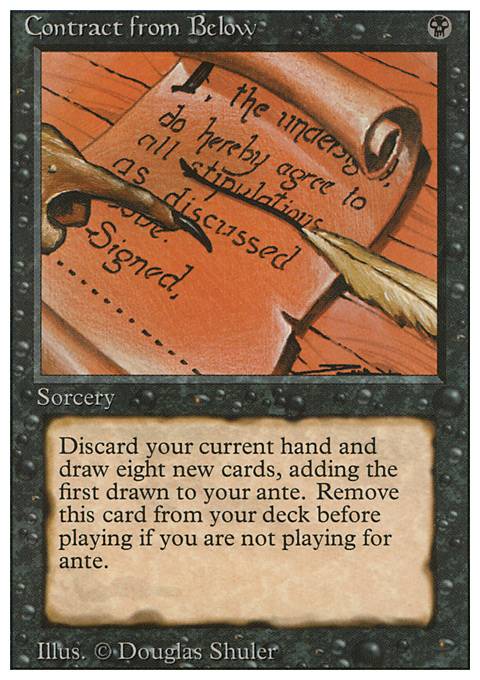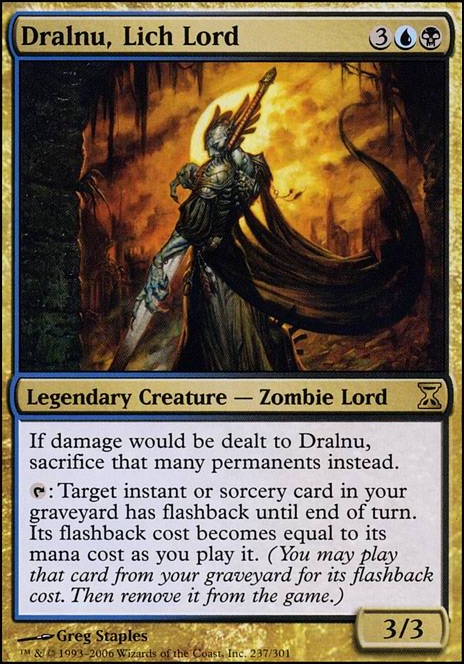The worst card type in the game is the 'Creature' type. Creatures are weak. Creatures are slow. Most of the time they die without accomplishing anything. We do not need them to slaughter our opponents. Creatures are useless (or banned, poor Griselbrand).
All Dralnu decks I have seen fall into two categories:
- The good ones, that focus on burying the opponents under a huge but finite amount of extra turns, thus annoying them to death.
- The bad ones, that just durdle around with garbage cards like River Kelpie, Wrexial, the Risen Deep and Catalyst Stone
The extra turn strategy is not one that I'm particularly interested in, also because some of the required cards are too expensive IRL. I'll try to do something a bit different with this deck.
The theme behind it is basically "high risk, high reward". I want to mess with dangerous but powerful cards like Doomsday, Enter the Infinite and Demonic Consultation, I love the concept of exploiting dangerous symmetrical effects like Show and Tell, Dream Halls and Hive Mind. I like the idea of going all in on a combo with the risk of fizzling, miscalculating or getting stopped and lose on the spot. Dralnu himself is the symbol of such idea with his awful drawback paired with his powerful ability.
Greatness at any cost is indeed the idea behind the black slice of the color pie, as clearly shown with the most powerful card ever printed: Contract from Below, a card too powerful to be even part of the game itself.
This is a (almost) creatureless combo deck with a bit of control elements to stabilize in the early game. The main plan here is to deck ourselves with Laboratory Maniac in play. Labman is indeed the real general of the deck and we have several ways to enable him:
- Doomsday, such a powerful and cool card. Typically the doomsday pile involves Gitaxian Probe, Gush and Brainstorm.
- Enter the Infinite, usually cheated via Dream Halls or Omniscience + Show and Tell
. A resolved Enter the Infinite is basically impossible to beat.
- Demonic Consultation, probably the most efficient way to empty a library ever printed. However, you do not want to risk it unless you are in a really desperate scenario.
We need to include at least a way to recover our win condition from the graveyard in case something goes wrong. It would really suck to have Omniscience in play, the entire library in our hands and labman sitting in the yard without a single way to get him back. Therefore we run Unearth for that single purpose. It's cheap and we have the possibility to cycle it away when not needed. Also, Doomsday is able to get labman back from the deads while setting up the win. The only other reanimation spell that I would consider, instead of Unearth, is something like Necromancy due to the instant speed potential.
It may happen that, for whatever reason, labman gets exiled. In case of such a tragedy, I have devoted a few card slots to alternate win conditions that synergize with the core of the main plan.
The rest of the deck consists in a few mana rocks, a bunch of efficient counterspells and spot removal, a few versatile mass removal spells and the actual mechanism that sustains the deck: cantrips, draw spells and a few tutors. The two main lines of play ( Doomsday into labman and Dream Halls/Omniscience into Enter the Infinite) require good draw capabilities:
- any serious Doomsday player knows that, if you cast such spell without winning in that very same turn, you are doing it wrong. Therefore, after paying BBB, we need to navigate through the entire doomsday pile and somehow pay 2U for the labman, possibly with some mana open for counterspells.
- often, when we cast Dream Halls or Omniscience, Enter the Infinite is still lost somewhere inside the deck. The key here is to chain draw spell after draw spell until we either reach Enter the Infinite or any card that can tutor for it. To achieve this without fizzling halfway through, we play a high density of spells that draw at least three cards. This is particularly relevant because the easier and more common route for the combo involves Dream Halls, a card with a lot of raw power but that needs careful support. We need to draw more cards than the ones that we discard to Dream Halls (2 for each spell cast).
Also, with such a few key combo cards that we need to find every game, we need ways to consistently dig deeply inside the deck.
The last card that requires an explanation is Mind's Desire. This is more a pet card of mine and the deck doesn't really need it. However, it can act as a bridge between the Dream Halls/Omniscience route and the Doomsday kill. When chaining draw spells the deck naturally tends towards a little bit of Storm (which I love but I am not able to execute) and Mind's Desire can help to get to Enter the Infinite or can go through an entire Doomsday pile with a storm count of just 4. The latter scenario constitutes the coolest win that I have ever seen.
So, why Dralnu? First of all, we play Dralnu, Lich Lord over Kess, Dissident Mage for two reasons:
- no doubt that Kess is a stronger and more pushed card, but Dralnu is infinitely more cool
- one of the defining cards of the deck is Dream Halls that is simply not sustainable in a tri-color deck
That being said, we do not care too much about Dralnu. Most of the times he doesn't even leave the command zone. A lot of Dralnu players make the usual mistake of building the entire deck around the commander. In the case of Dralnu, such approach is particularly bad due to the necessity of devoting a ton of card slots to all sorts of protection for him.
We do differently. Dralnu is just a (cool) creature and, as I said at the beginning, we don't need creatures. If there is any red player at the table, we don't even consider the possibility of casting him. In general, we only use him when we have nothing else to do or when we need a shortcut to close out the game.
Finally, let's discuss some card choices. We do not run Ad Nauseam, Dark Confidant and other black staples due to the high casting cost of a lot of our cards. Yes, Ad Nauseam storm is stronger but it leads to pretty straightforward deckbuilding that I don't want to replicate. Same goes for blue infinite mana combos with X spells as mana sinks. For these reasons the deck's goal is not to be a tuned cEDH deck, even if it's clearly not a casual deck. I see it as something in between.
Also, a lot of card slots can be optimized, for example:
and probably other things


